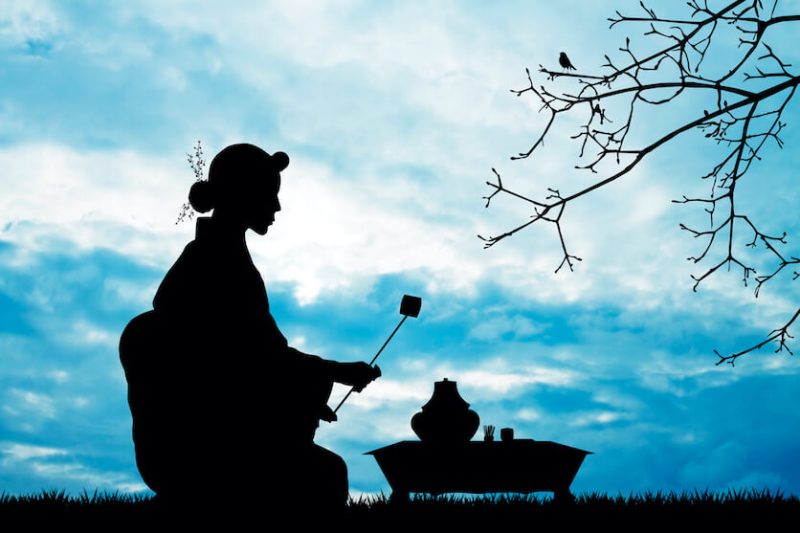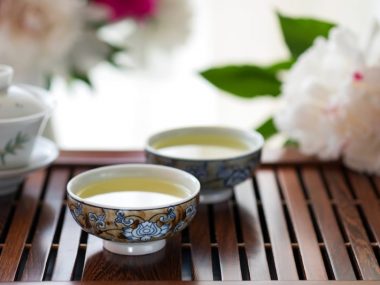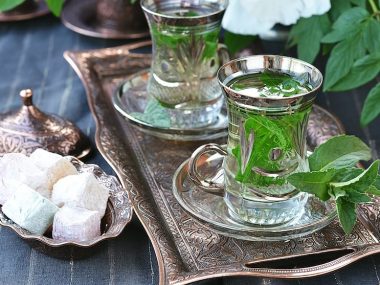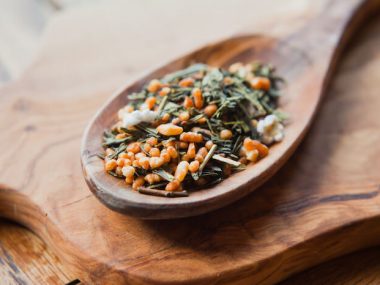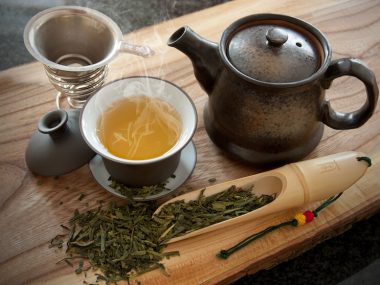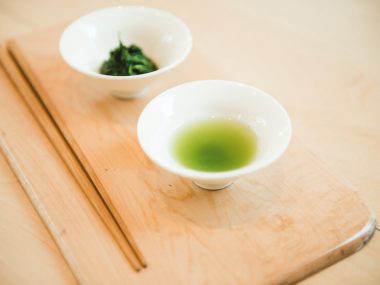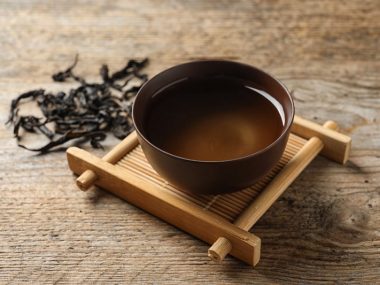We open the first door to find it leads to another, and another, and even more! Discovering this new world of Japanese tea causes you to pause with wonder at just how vast green type tea is and how many marvelous taste profiles it can have!
Table of Contents
What Is Japanese Tea?
Japanese tea is not a specific type of tea but rather a reference used to describe teas cultivated and processed in Japan. There are hundreds of different Japanese teas, all of which come from the Camellia sinensis tea plant or one of its numerous cultivars.
What Kind of Tea Do the Japanese Drink?
The Japanese tea culture typically consumes green tea. When you compare that to westernized regions, westerners seem to prefer black tea. With the influx of other types of tea, green tea consumption in Japan has declined. However, it is still the tea of choice.
Types Of Japanese Teas
When it comes to Japanese green tea, there are far too many to list. We’ll take a look at those most commonly enjoyed ones.
Sencha
Sencha tea is the most consumed tea in Japan. It also accounts for 80% of Japan’s tea trade. To produce Sencha, tea growers shade the plants before harvesting. At harvest, the upper leaves are picked while leaving the lower leaves for Bancha tea.
- Processing Method: steaming
- Flavor: grassy, earthy, seaweed
Bancha Tea
Bancha tea is made from the lower leaves and stems of the tea plant. In comparison, Sencha is made from the upper leaves. So, bancha is perceived as a low-grade, “commoner’s” tea.
- Processing Method: pan-roasted
- Flavor: sweet and nutty
Fermented
Fermented Japanese teas include Goischicha, Awa Bancha, Kurioshizucha, Yamabuki, and Nadeshiko. These teas are produced with post-fermentation (lasting weeks to months) after processing the tea leaves.
- Processing Method: boiling
- Flavor: varies according to the specific fermented tea
Genmaicha
Genmaicha is a wonderful green tea to enjoy as a savory treat. This tea is made from Sencha tea and has roasted rice added. Matcha powder may be used to enhance the color of Genmaicha’s green appearance.
- Processing Method: same as for Sencha but with rice addition
- Flavor: nutty, toasty
Gyokuro
Gyokuro tea is somewhat unique because it is shaded several weeks before harvesting. This long shading method causes the tea leaves to be small, furled up and a needle-like shape. Intense shading also increases the levels of amino acids, sugars, and flavonols.
- Processing Method: 3-4 weeks shading before harvest
- Flavor: Umami, seaweed, less astringent
Hojicha
Hojicha tea (also known as houjicha) is made from the coarse leftover leaves and stems of Sencha. What sets Hojicha apart from other green teas is its smoky aroma and flavor.
- Processing Method: roasting over a charcoal fire
- Flavor: toasty, smoky
Kyobancha
For a low-caffeine green tea, Kyobancha (also known as akachan bancha) is a rarity typically obtainable only in Japan.
- Processing Method: using overwintered tea leaves and stems
- Flavor: woody, roasty
Kukicha
Kukicha is referred to as “poor man’s tea” (also called bocha). It is also a low caffeine tea because it is made from the leftovers of Sencha.
- Processing Method: leftover stems and twigs of Sencha
- Flavor: mild, nutty, creamy
Japanese Milk tea
Japanese milk tea is a bubble (boba) tea made with a milk base, black tapioca pearls, flavorings, and other additives (such as tea, herbs, fruit, etc.)
Oolong
Oolong tea is also known as “wulong.” It is the most common tea used in the traditional Chinese Gongfu tea ceremony. There are different varieties of oolong, which include Jin Xuan, Ti Kuan, Da Hong Pao, and Se Chung. Still, it is widely consumed in Japan too.
Tencha
Tencha is cultivated and harvested to make Japanese matcha tea powder.
- Processing Method: shading, steamed, dried, ground into powder form
- Flavor: umami, sweet, astringent
Wakoucha
Wakoucha tea is Japan’s black tea (known as koucha). Although it’s a black tea, it produces a red-colored tea. This tea is known for its robust, malty sweet, bitter flavor.
Miscellaneous Tea
The consumption of tisanes (herbal tea) is popular in the Far East for medicinal purposes. Some of these herbal teas may include Japanese ginger tea or Japanese barley tea. Traditional and Chinese medicine relies heavily on tisanes to treat numerous ailments.
What Does Japanese Tea Taste Like?
There are hundreds of different Japanese teas, so to pinpoint what they taste like is impossible. Green tea typically has a more earthy flavor base. The tea culture across the globe has a preferential choice of true tea. Some countries are more inclined to one type of true tea, whereas others like something different.
How Much Caffeine Is In Japanese Tea?
Because there are hundreds of different Japanese teas, we can’t specify the exact amount of caffeine in tea. Since most of these teas are green tea, you can expect to have up to 30 mg of caffeine in a typical cup of green tea such as Sencha.
What Is Traditional Japanese Tea?
To describe a traditional Japanese tea is like finding the right words to depict a tea ritual that exudes graceful, elegant movements with intention. In the center of the stage is tea and the ceremonial host is the vessel that provides the means to transform that which appears to be lifeless into a living, breathing experience all within a teacup.
The Japanese incorporate their heritage and teachings into various tea ceremonies. Tea is more than a beverage but an ancestral link. Every tea ritual has predefined movements carried on for thousands of years, most of which are the same today as they were back then.
Japanese Tea Ceremonies
Tea ceremonies are quiet, respectful, and symbolic of purification for those present. To become a ceremonial host, one must attend special schools to learn and is required to practice for many years.
Japanese tea ceremonies are known as Chanyou or Sado. Informal ceremonies are called “Chakai,” whereas more formal gatherings are called “Chaji.” Ceremonial hosts prepare and serve matcha green tea.
Classification Of Japanese Teas
Asian countries such as China, Taiwan, and Japan have their own system to grade or classify a true tea (black, green, oolong, yellow, white.)
Unlike India, Africa, or Sri Lanka, Japan grades its tea by two basic criteria:
- The part of the plant used to produce the tea
- Harvest time.
India, Africa, Sri Lanka, and other countries (outside of Asia) grade by the size of the leaf and which flush (harvest) it falls within.
When trying to break down the Japanese grading system, we found that there are a few basic classification terms they use, which include Sencha, Gyokuro, Matcha, Bancha, or Kukicha.
Sencha
- Parts of the plant used: upper leaf of the 1st/2nd flush
Gyokuro
- Higher grade
- Parts of the plant used: furled up needle-like new leaves
Matcha
- Made from Tencha
Bancha
- Lower-grade
- Parts of the plant used: lower leaves and twigs of 3rd/4th flush
Kukicha
- Parts of the plant used: stems, stalks, twigs
Other terms may be used to classify Japanese tea include such as:
- Extra Choicest
- Choicest
- Choice
- Finest
- Fine
- Good Medium
- Medium
- Good Common
- Common
- Nubs
- Dust
- Fannings
We have only touched on the surface of the multi-layer tea classification system Japan uses. Other factors also determine where the tea falls within the tea hierarchy in Japan. Things like the type, part of the plant used, and flush (harvest) are what we have briefly covered. However, going deeper, they also consider how long the tea was steamed for, how oxidized it is, where the tea was grown, and what cultivar was used.
Comparison Of Japanese Tea And Other Teas
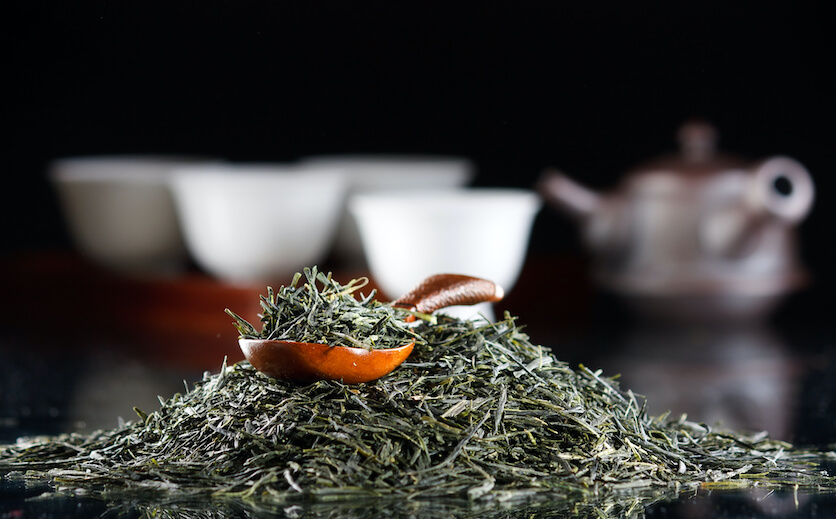
It goes without saying that the flavor of the tea is perhaps the common denominator that determines what tea a tea drinker prefers. The health benefits are secondary.
Is Japanese Green Tea Better Than Chinese?
Chinese green tea tends to be lighter and sweeter in overall flavor, whereas Japanese green tea has a more vegetal, umami flavor. Processing tea in China includes pan-frying, or baking whereas Japan steams their tea. The difference in green tea processing contributes to how the tea will taste. Some tea drinkers may prefer smoky, toasty teas, while others prefer green tea to taste earthier. It all comes down to what one desires in flavor.
Is Sencha Better Than Green Tea?
Sencha is a green tea. The only thing that sets it apart from other green teas is cultivation, harvesting, and processing. So it’s not quite accurate to compare this tea variety to an overarching category.
How Good Is Japanese Tea For Health Benefits?
According to a research article entitled “An Update on the Health Benefits of Green Tea,” green tea has beneficial catechins. These catechins exhibit bioactive activity against inflammation, heart disease, dental conditions, oxidative stress, and infection.
Overall, all green Japanese teas are considered to have a positive effect on overall mood and well-being. But the exact benefits vary from one tea variety to another.
How To Drink Japanese Tea
There are numerous Japanese green teas that beckon you to try them. However, there is one that is super delicious, and with a bit of tweaking, you can have yourself a nice afternoon tea and treat in one!
Genmaicha Gotcha
This feisty green tea is nice to enjoy anytime, but especially on those days when a head cold won’t let up, and you need a bit of relief. Whether you have a cold or not, this tea recipe is great to enjoy anytime.
Ingredients
- 2 teaspoons of loose-leaf genmaicha green tea
- ⅛ teaspoon of ground jalapeno (or a tiny pinch of cayenne) powder
- 2 cups of water
Directions
- Bring the water to a boil.
- Remove from the heat.
- Place the loose-leaf tea in a tea infuser.
- Drop the tea infuser into the hot water.
- Add the jalapeno powder.
- Cover and allow to steep for 5 minutes.
- Remove the cover.
- Remove the tea infuser.
- Pour the tea into a teacup and enjoy!
An Infinite Peeling Of An Onion?
Gaining an understanding of the massive scope of Japanese green teas, their classification, and everything in between is mind-boggling. There is much more to learn in addition to what we have covered. Discovering what the best Japanese green tea is will require more in-depth reading to continue peeling this onion.
